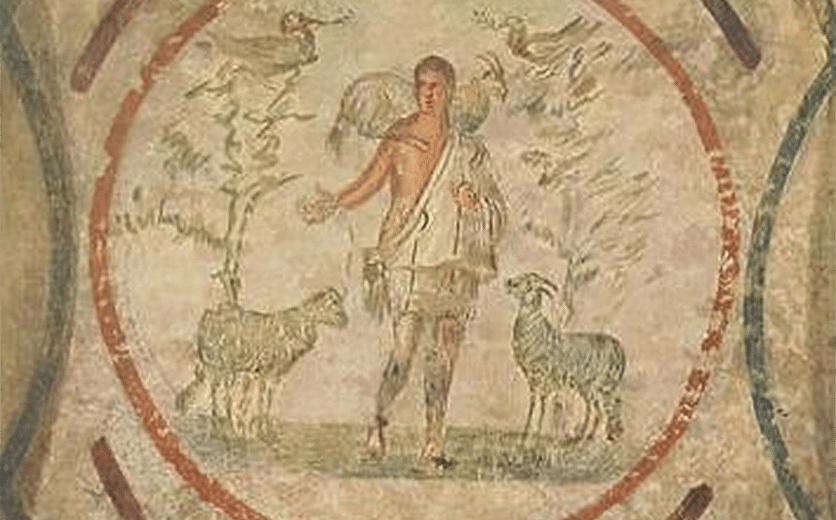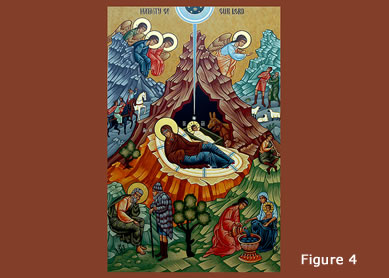The Good Shepherd is by far one of the most common images in early Christian art, likely due to its emphasis on the possibility of forgiveness and salvation for faithful Christians. One famous example is its depiction on the central dome in the Cubiculum of the Veiled Woman in the Catacombs of Priscilla, a third-century burial complex on the Via Salaria in Rome. Early Christians would congregate in the Catacombs of Priscilla to mourn the dead and perform rituals, such as the Eucharist. Given the extensive shepherd imagery in both the Old and New Testaments, it is not surprising that the Good Shepherd became such a common motif in early Christian art. However, it may come as a surprise that some of the details borrow from common non-Christian iconography.
What non-Christian elements appear in early Christian depictions of the Good Shepherd?
One non-Christian element that appears in the Good Shepherd painting in the Catacombs of Priscilla is that of Hermes Criophorus, or Hermes the ram-bearer. In Greek contexts, Hermes was a Greek god associated with fertility, trade, and animal husbandry. He was often portrayed as a man with a sheep over his shoulders, showing that the deity protected his followers and demonstrating the importance of charity as a social value. This image appeared most often in funerary art, where the viewer could understand the image as Hermes guiding a recently deceased follower to the underworld. Likewise, at Christian sites, we tend to see the Good Shepherd in funerary art, as in the Catacombs of Priscilla. In fact, the same image of Hermes Criophorus is echoed in the Catacombs of Priscilla—a figure holding a ram around his shoulders stands in the center of the composition, asking the viewer to focus on his protection of the ram. In the Catacombs of Priscilla, the Good Shepherd represents Christ’s protection over the dead and his willingness to lead them to salvation, much like the Greek Hermes.
Another common Greek funerary figure was that of Orpheus in paradise. Orpheus was a legendary hero who is said to have journeyed to the underworld in search of his deceased wife. In funerary art, Orpheus would be surrounded by trees, and the image symbolized his satisfaction with life. That blissful figure also appears in Christian versions. The iteration in the Catacombs of Priscilla, for example, shows trees on either side of the shepherd, along with greenery at his feet. It may be significant that the image is symmetrical; there are an equal number of trees and animals on either side of the shepherd. That symmetry contributes to a sense of balance and completion in the image. Hence, the image may also seek to comfort the viewer by reassuring them of the satisfaction the deceased found in life and will find in the afterlife with Christ.
Are there any uniquely Christian elements?
In addition to the non-Christian elements of the image, though, there are some uniquely Christian features of the overall piece. For example, there are two doves at the top of the trees, both holding olive branches in their beaks. These are a common Christian symbol for peace that derives from the story of Noah and may represent a sense of peace for the deceased. In the image, the shepherd also separates the sheep and goats. Shepherd figures and images, which have long history in the ancient Near East and the Greco-Roman World, become distinctly Christian when surrounded by other images extensively used by Christians. This particular Good Shepherd is surrounded by the biblical scenes of Abraham’s sacrifice of Isaac (Gen 22:1–24), the three Hebrew youths in a fiery furnace (Dan 3), and Jonah being disgorged by the big fish (Jonah 1–3).
Christians also expanded the common contexts of the Good Shepherd image to better suit their needs. For example, the image also became fairly popular in baptismal contexts. This may be because, for Christians, a baptism is essentially a form of death and rebirth, one that benefits from the presence of a soothing, guiding figure. Despite the different possible contexts, however, the Christian Good Shepherd always seems to suggest an inherent desire of early Christians to focus on the power of Christ’s protection and forgiveness. In all portrayals, we see the shepherd carrying a sheep, symbolic of his eternal protection of his followers. The image suggests an investment in the possibility of salvation, forgiveness, and Jesus’s care and comfort in early theology. All of these qualities were likely welcome reminders in the face of early Christian persecution.
Given its ability to comfort those facing the disenfranchised, we might expect the Good Shepherd image to decrease in popularity after Constantine made Christianity the official religion of Rome in 313 CE. Interestingly, this was not the case. The Good Shepherd remained a popular image for decades after Constantine. Indeed, it remained prevalent in the Christian iconographic lexicon until the fifth century, well after Constantine’s death.






